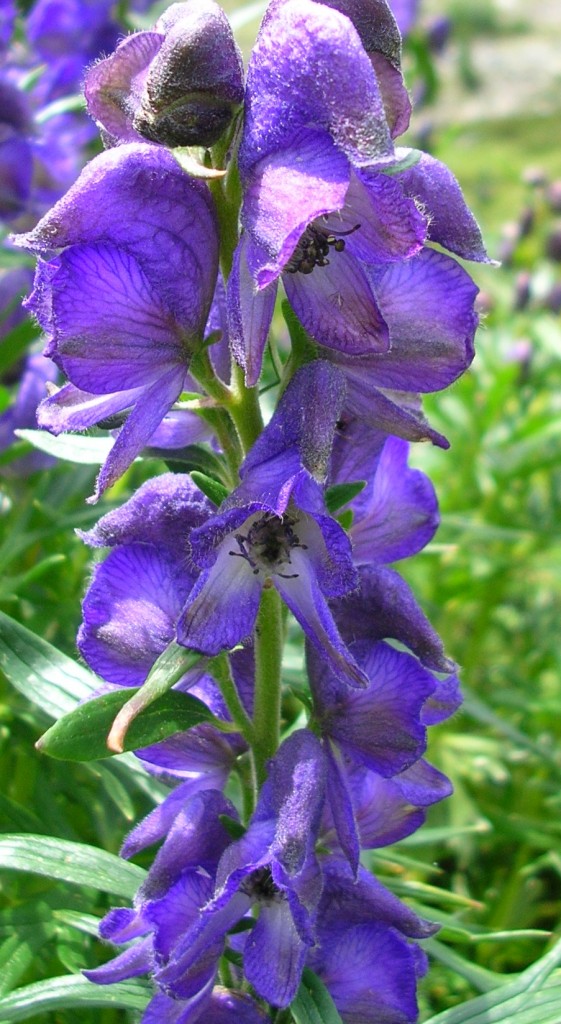 Also known as wolfsbane and monkshood, Shakespeare’s Aconitum is probably the perennial A. napellus, one of 100 species of Aconitum, a genus in the buttercup family, Ranunculaceae. A. nepallus is native to the mountains of France, Switzerland, and Germany and is a popular garden plant both in Europe and the US. It bears erect dense spikes 3-4’ tall of showy hooded flowers in late summer. Each flower is made up of five dark blue-violet petals-like sepals, the top-most of which forms a hood-like structure. The leaves are dark green on the upper surface, lighter green on the lower surface, and are deeply divided to the base and then divided a second time into fine linear segments. Plants like dappled shade and rich, evenly moist, well-drained soil, and are best suited to areas where night temperatures drop below 70 F degrees in summer. All parts of the plant are poisonous.
Also known as wolfsbane and monkshood, Shakespeare’s Aconitum is probably the perennial A. napellus, one of 100 species of Aconitum, a genus in the buttercup family, Ranunculaceae. A. nepallus is native to the mountains of France, Switzerland, and Germany and is a popular garden plant both in Europe and the US. It bears erect dense spikes 3-4’ tall of showy hooded flowers in late summer. Each flower is made up of five dark blue-violet petals-like sepals, the top-most of which forms a hood-like structure. The leaves are dark green on the upper surface, lighter green on the lower surface, and are deeply divided to the base and then divided a second time into fine linear segments. Plants like dappled shade and rich, evenly moist, well-drained soil, and are best suited to areas where night temperatures drop below 70 F degrees in summer. All parts of the plant are poisonous.
Shakespeare mentions Aconitum specifically in 2nd King Henry IV (act iv, sc. 4 ,44) comparing it to gunpowder.
King Henry speaking says to his son, Thomas Duke of Clarence:
The united vessel of their blood,
Mingled with venom of suggestion
As, force perforce, the age will pour it in
Shall never leak, though it do work as strong
As Aconitum or rash gunpowder.
In , Romeo and Juliet (act v, sc 1, 59) Romeo asks for an unnamed poison as violent as gunpowder.
Romeo:
Let me have
A dram of poison, such soon speeding gear
As will disperse itself through all the veins,
That the life-weary taker may fall dead
And that the trunk may be discharged of breath
As violently as hasty gunpower.
Although not specifically identified, the poison was most certainly Aconitum, well known at the time for being deadly. Gerard, writing in 1597, mentions that it was “deadly to man and all kindes of beasts.” The efficacy of Aconitum as a poison goes back to ancient Greek times when, both Hecate, the Greek goddess of magic arts and spells, is said to have poisoned her father and Medea is said to have killed Theseus with Aconitum. In the Middle Ages witches mixed Aconitum with belladonna to make an ointment they rubbed on their body for flying.
The generic name “Aconitum” comes from the Latin name, Greek akoniton, for this group of plants. The specific epithet, napellus, is the diminutive of napus, Latin for turnip, which the root of A. napellus resembles. The common name, monkshood, refers to the petal-like sepal that forms a hood at the top of the flower, while the common name wolfsbane refers to the use of the plant to poison wolves with the alkaloid derived from the root.